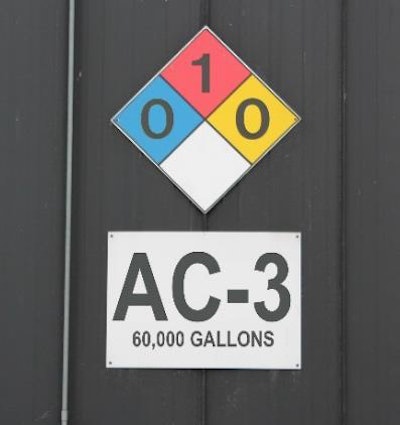
DISCLAIMER: This information should not be construed as formal industry recommendations, legal advice or legal opinion on any specific facts or circumstances. This information is intended for general purposes only, and you are urged to consult your own attorney or consultant on any specific legal or compliance questions you may have regarding your specific situation.
Markings for tanks that contain AC binder, fuel oils, and even asphalt mixture can be confusing because requirements span a number of different federal, state, and local agencies. The labeling information provided in NAPA’s tank inspection guidance document (IS 137 Supplement) should be sufficient for compliance with federal and most state and local requirements with the inclusion of a tank numbering/identification system. More specific information is provided in this report.
Three basic sets of regulations govern requirements for marking liquid storage tanks: federal and state environmental agency rules, OSHA’s Hazard Communication standard, and local fire district requirements. State- and jurisdiction-specific markings may also be required: please check with appropriate state and local agencies.
For asphalt cement (AC) binder storage tanks, the following information should be readily visible from the ground:
- Tank Number/Identification, e.g., AC-1, AC-2, Tank 303, Tank 304, etc.
- Identification of Tank Contents, e.g., Asphalt Cement, PG 76−22, etc.
- Storage Capacity of the Tank
- Hazard Warning: use a NFPA hazard diamond consistent with information on the supplier’s Safety Data Sheet and your assessment of hazard classification/rating.
Similar labels may be required for fuel storage tanks, chemical additive tanks, or other liquid storage tanks. In addition, signage similar to “Caution: Hot” may be appropriate near any sampling or access point where there is potential for workers to contact hot surfaces or liquids.
It's recommended the markings outlined above be placed in relatively close proximity to each other on the tank, and they should be placed so that the markings are visible from the facility’s entrances or the public right-of-way. Some jurisdictions require markings to be repeated at 180-degree intervals; check local requirements. Unless state or local regulations dictate otherwise, there appear to be no definitive generic requirements specifying the size of lettering or other information other than it must be “visible” (from ground level or a short distance away). A conservative approach, as recommended in NAPA’s tank inspection guidance document (IS 137 Supplement), is for written information on a tank to be in letters at least 6 inches high.
Depending on how a company classifies asphalt pavement mix under OSHA’s Hazard Communication standard (see below), markings may also be required on asphalt mix silos.
Background
Federal and State Environmental Regulations
Federal environmental regulations are unusually silent on labeling requirements for bulk storage of petroleum liquids in aboveground storage tanks (ASTs). U.S. EPA recommends and many states require, at a minimum, the following markings: the identity of the material stored, a tank-identification metric, and the capacity of the tank (see Section 6.4.3 of EPA 550-B-13-001, SPCC Guidance for Regional Inspectors). These markings may be separate or in combination, for example, AC-2(20k) would suffice to indicate that Tank #2 holds 20,000 gallons of asphalt cement. Although not required under federal rules, some states also recommend the use of an upper safe-fill level indicator (this could be an external tank gauge); however, federal SPCC rules adequately address this risk by requiring overfill protection.
Most states and many counties and municipalities have jurisdiction-specific regulations governing tank labeling and marking. For example, New Hampshire requires 2-inch-high lettering painted in a color that contrasts with the tank’s color (NH DES Fact Sheet). The city of San Diego requires labeling on storage tanks to be visible from 300 feet and provides minimum size requirements for signage (SD Fire Prevention Bureau Policy). West Virginia requires tank labels/markings be placed at least 3 feet above ground and visible/legible from a public right-of-way or from outside the containment area (WV DEP Aboveground Storage Tanks Rule, Section 5.7). Because jurisdiction-specific requirements regarding tank labeling and markings may differ, it is important to fully understand all local requirements.
OSHA’s Hazard Communication Standard
Under the HazCom standard, OSHA requires some type of product/hazard identification for all “hazardous” or “classified” chemicals, even if they are contained in a temporary secondary container. ASTs are considered secondary containers and although they are not required to display GHS-compliant labels, they must display basic health hazard information and identify the material being stored. This can be accomplished through the posting of an NFPA 704 hazard diamond or an HMIS label, so long as employees are trained on the label’s use (OSHA Brief BR-3636 2/2013). Differences in the information conveyed with the two labels focuses on typical occupational exposure to the stored material (HMIS) or potential contact with the chemical under emergency conditions (NFPA), such as firefighting (see HMIS and NFPA Labeling Systems).
The NFPA hazard diamond with appropriate health identification would be applicable for both AC binder and fuel oil tanks, and is the recommended hazard communication label because it is already required under fire codes. The need to display hazard information on an asphalt mix silo, however, would likely depend on whether or not a company classifies asphalt pavement mix as “hazardous” under OSHA HazCom standard (see NAPA Special Report 212).
Fire District Requirements
Generally, local and state fire districts require certain markings for storage of flammable and combustible liquids. Although AC suppliers do not always identify it as such, AC binder should be considered a Class IIIB combustible liquid (see Fire and Explosion Hazards Handbook of Industrial Chemicals and OSHA Standards Interpretation). Storage and container markings for combustible liquids are governed by NFPA 30, which requires hazard markings on tanks that exceed 60 gallons for fixed tanks, 660 gallons for portable tanks, and 793 gallons for bulk containers of liquid petroleum. Chapter 9 of NFPA 704 outlines the requirements for hazard identification using the NFPA hazard diamond and identifies sizing constraints for markings. Online access to NFPA codes is free with registration.
In general, it is recommended that each storage tank for flammable or combustible liquid display an NFPA 704 label consistent with the NFPA classification included on the supplier’s Safety Data Sheet (SDS). However, there may be inconsistencies and contradictions in how different manufacturers of petroleum AC binder identify the material’s NFPA and HMIS ratings; the facility owner/operator has the ultimate responsibility and authority to accurately mark NFPA and HMIS labels. For example, supplier SDSs may state a 0, 1, or 2 for the NFPA Health category. Local agencies may proscribe specific values; for example, the Minnesota State Fire Marshall Division specifies 0 for the NFPA Health category (SFMD AST Plan Review Fact Sheet).
Typically, unmodified asphalt binder can be designated under NFPA 704 as follows:
Health (blue): 0
- Flammability (red): 1
- Instability (yellow): 0
- Special Hazards (white): usually left blank
Some companies may indicate a W in the white Special Hazards diamond to warn against the use of water as a fire suppressant. Please understand and follow your local fire department’s labeling requirements. Consider conducting a walkthrough of your facility for first responders to familiarize them with potential hazards on the site.
NFPA designation for firefighting purposes would not be required for asphalt mix silos because the stored material is not a combustible liquid. However, depending on how asphalt mix is or is not “classified” by a company for its OSHA GHS-compliant SDSs, some type of hazard designation and material identification may be required on asphalt pavement mix silos.
For more resources, visit NAPA's Online Store.















